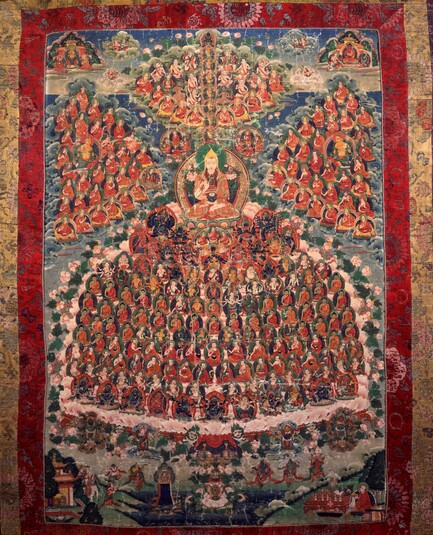
Item: Refuge Field (Buddhist) - Gelug Lineage
| Origin Location | Tibet |
|---|---|
| Date Range | 1700 - 1799 |
| Lineages | Gelug and Buddhist |
| Material | Ground Mineral Pigment on Cotton |
| Collection | Private |
Classification: Object/Concept
Tsongkapa: surrounded by lineage teachers above and to the sides with meditational deities and protectors below - the Field for the Accumulation of Merit (Tib.: tsog shing).
Tibetan: Tsog shing Tibetan: Lama Tsongkapa
Tibetan: Lama Tsongkapa
Field of Accumulation, or Refuge Field: A Refuge Field is a particular type of Buddhist, and in recent times Bon, painting composition that arranges all of the teachers and deities of a particular tradition in one painted composition as formulated by individual religious traditions and as described in liturgical texts. The function of a Refuge Field is to be a visual composition reminding the devotee of all of the most sacred objects contained in the tradition, namely the (1) Teacher, (2) Buddha, (3) Dharma - religious texts, (4) Sangha, (5) Ishtadevata - meditational deities, and (6) Dharmapala - the Religious Protectors, including wealth deities. It is this hierarchical grouping of teachers, books and deities that are the Field of Accumulation - the basis upon which merit (in a Buddhist sense) can be accrued.
n the Gelug Tradition of Tibetan Buddhism there are numerous Refuge Field composition types distinguished both by central figure and also by support (i.e. lotus or tree): (1) Shakyamuni Buddha, (2) Je Tsongkapa, (3) Pabongka Design, and (4) Lotus Support, and (5) Block Print. The first three types are depicted at the peak of a wish-fulfilling tree, seated on a throne and lotus. The fourth type is placed only on a lotus blossom. The two general types of central figures for all types of Refuge Fields are Shakyamuni Buddha and Je Tsongkapa. The variation of the two subject figures depend on the intention, purpose and function of the painting. The former is a Lama Chopa (Shakyamuni) Refuge Field and the latter a Lamrim Lineage (Tsongkapa) Refuge Field. The various Gelug Refuge Fields are a 17th century development based on the 15th and 16th century compositions of Tsongkapa and the Yogachara and Madhyamaka lineages.
Jeff Watt 4-2011
Subject: Refuge Field Main Page
Collection: Private 5
Subject: Refuge Field, Gelug (Tsongkapa)


